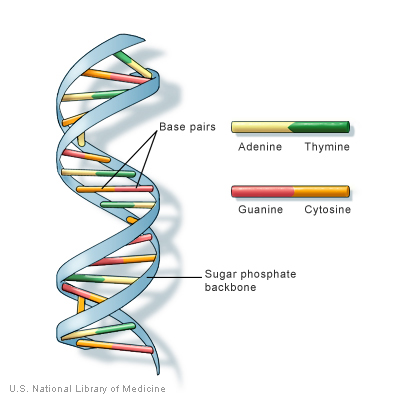The basic mechanisms of evolution Since
seem to lie the origins of the criticism of the theory of evolution in most cases to a general lack of understanding, I will try below to explain the basics in a simple and easy to understand. Too often we hear of atoms that collide randomly and suddenly to form highly complex DNA. Or giraffes are suddenly turned into elephants or whales. Of monkeys, which eventually had no desire to bananas and were more easily to people. Who sets these rates in the world proves that the only thing that the object of his criticism has not understood at the outset. Therefore, now the basics, queries and comments are welcome:
The DNA
Every living thing is defined substantially by a molecule: the DNA, or deoxyribonucleic acid (German: DNA or deoxyribonucleic acid). This is in the form of various base pairs a tremendous amount of information stored, which can be compared with a blueprint of the organism. Every living being has a unique DNA, which is in every body cell and controls the synthesis of various substances.

The DNA double-strand containing the base pairs in the middle of the genetic information
The mutation - the "accident"
At each cell division, DNA is copied, so that it is fully present in both daughter cells. This process is accomplished by enzymes that split the double strand into two single strands at first. Since each of these single strands complementary to the other, is thus almost as a mirror image, it is sufficient to bring both strands of the appropriate base to obtain two new double strands should be exactly the same. If, for copying several hundred million base pairs occur necessarily for errors. Will not eliminate in large part by specialized repair enzymes again, but a few bugs remain so. In addition to these copying errors, there are other factors that may change or mutate DNA. Internal factors such as free radicals, particularly reactive molecules, have just as a mutagenic effect on DNA as well as external influences, such as certain forms of radiation and chemicals. These factors contribute to the DNA of all living things. For creatures like us people who do not multiply by cloning, is added in reproduction is another factor: the DNA of the parents is mixed.
The gene pool
All these influences have the effect that every living being a group in their own unique DNA, has set it apart from all others. And all these different DNA variants in the group of the population, make their so-called gene pool.
The selection
This term describes the much-quoted survival of the fittest. The gradual demise of the individuals and the gradual sorting out of the DNA variants from the gene pool of a population that are not well adapted to their environment, that is the selection. Thus able to survive with limited resources, only the individuals who cope best with their environment. The less well-adapted individuals reproduce on average less often leave because they are such bad food, no dealing with weather conditions and die before the age of reproduction. Or may provide for the poor reproduction of the offspring. In the long term, the population thus consists of better adapted Organisms, the gene pool, which is indeed for the DNA of the entire group is changing.
The genetic drift
Another important mechanism that can change a population, the genetic drift. With each birth, the characteristics of the parents, the alleles, thrown together by chance at a new genome. It may happen that did not inherit certain characteristics. In the longer term or in a small population may, if it happens gradually in all individuals, lead to a feature disappears completely. It is even possible that by sharing some alleles in one part of the group and the disappearance of these features from the other part of the group are two different populations. For larger groups, but this is unlikely. Interestingly, the genetic drift as disasters that will eradicate much of the population. That leaves only a few individuals that may not correspond to the genetic mediocrity of the original group. They and their descendants experienced in such a case a strong change of the gene pool in a very short period of time.
A new species
... is defined as a population that is not genetically compatible with other populations and reproduce only among themselves can. But how can create a completely new species? The two latter factors are responsible. By the unlikely event of a divergence of two groups in a population by genetic drift. Or the occurrence of an event that changed much of the population and therefore extinguishes the most gene variants and thus the gene pool dramatically. The spatial separation of a population in different ecosystems such as the elimination of a land bridge between two islands can produce a new species. The selection shall, in each of the two now separated from each other habitats that survival of the adapted individuals. Are these habitats to survive, the other DNA variants and the gene pools of the two new populations evolve in different directions. Up to a point at which the DNA is different between the two parties so far that a reproduction with the other group is no longer possible ...
 "Bleeding Heart"
"Bleeding Heart" 






